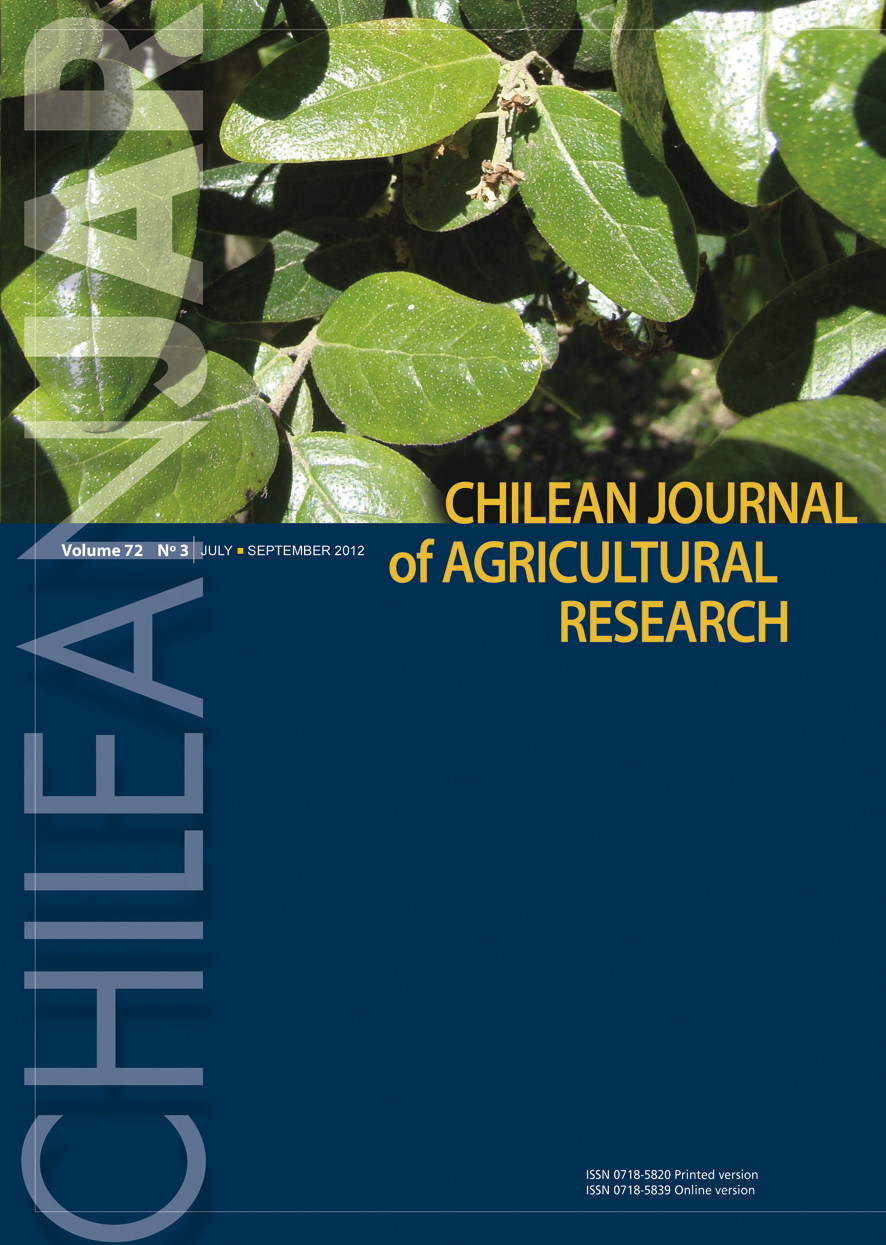
|
Chilean Journal of Agricultural Research
Instituto de Investigaciones Agropecuarias, INIA
ISSN: 0718-5820
EISSN: 0718-5820
Vol. 71, No. 1, 2011, pp. 16-22
|
 Bioline Code: cj11002
Bioline Code: cj11002
Full paper language: English
Document type: Research Article
Document available free of charge
|
|
|
Chilean Journal of Agricultural Research, Vol. 71, No. 1, 2011, pp. 16-22
| es |
Implementación y Evaluación de un Sistema de Análisis de Imagen para determinar la Viabilidad de Granos de Polen en Arroz Templado.
Rodrigo Ortega B.; Macarena Aresti E. & Iris Pereira R.
Resumen
La producción de arroz (Oryza sativa L.) en Chile está limitada principalmente por factores geográficos y climáticos. Las grandes variaciones de temperatura del agua y del aire afectan la viabilidad del polen, causando altos niveles de esterilidad floral ("vanazón"), reduciendo los rendimientos del cultivo. Conocer el número de granos de polen viable al momento de antésis permitiría determinar anticipadamente pérdidas de rendimiento por esterilidad floral; además, conocer el potencial de producción de polen viable sirve como una poderosa herramienta de selección en programas de mejoramiento y para determinar el efecto de algunos factores de manejo sobre la "vanazón". El recuento manual de polen total y viable no es práctico produciendo además resultados muy variables. El presente trabajo tuvo como objetivos desarrollar y evaluar un sistema para el recuento de polen viable y total en anteras de arroz, en base a análisis de imágenes. Al momento de antésis se recolectaron tres panículas de cada una de las parcelas de dos experimentos de campo donde se evaluaron los efectos de diferentes factores de manejo (variedad, altura de agua, dosis de N y arreglo espacial) sobre la esterilidad floral. Dos espiguillas y cuatro anteras se muestrearon desde cada panícula; los granos de polen fueron extraídos desde las anteras y se fotografiaron. Se realizaron recuentos manuales y digitales sobre las imágenes para determinar el número de polen total y viable. El recuento digital fue realizado con el software SigmaScan Pro, estableciendo algunos parámetros sobre la imagen antes del recuento. El recuento digital de polen alcanzó una buena precisión y exactitud y puede ser usado para estimar la viabilidad del polen y como variable respuesta para comparar tratamientos de manejo.
Palabras-clave
Cultivo de arroz, Oryza sativa, conteo de polen, análisis de imagen, antésis, esterilidad floral.
|
| |
| en |
Implementation and Evaluation of an Image Analysis System for Determining Viability of Pollen Grains in Temperate Rice
Rodrigo Ortega B.; Macarena Aresti E. & Iris Pereira R.
Abstract
Geographical and climatic factors limit the production of temperate rice (Oryza sativa L.) in Chile. Large thermal fluctuations of air and water temperatures affect the viability of pollen, causing high levels of spikelet sterility ("blanking"), resulting in reduced yields per hectare. Counting viable pollen grains, at the time of anthesis, may allow determining, ahead, whether there will be yield losses by spikelet sterility; besides, knowing the potential pollen viability serves as a powerful tool for material selection in breeding programs, and for determining which management factors may influence "blanking". If performed manually, counting total and viable pollen grains can be extremely tedious, producing highly variable results. The present work had for objectives to develop and evaluate a system, based on imagery analysis, for counting total and viable pollen in rice anthers. At the time of anthesis, three panicles were collected from plot treatments of two field experiments in which the effects of different management factors (variety, water height, N rate, and spatial arrangement) on spikelet sterility were evaluated. Two spikelets and four anthers were sampled from each panicle; pollen grains were extracted from anthers and photographed. Manual and digital counts were made on the images to determine total and viable pollen. Digital count was performed with the software SigmaScan Pro, setting some parameters on the imagery before counting. Precision and accuracy of the digital method were estimated. The results indicated that the digital pollen count showed a very good precision and accuracy and could be used to estimate pollen viability, and as a response variable to compare management treatments.
Keywords
Rice crop, Oryza sativa, pollen counting, image analysis, anthesis, spikelet sterility.
|
| |
© Copyright 2010 Chilean Journal of Agricultural Research.
Alternative site location: http://www.inia.cl
|
|
